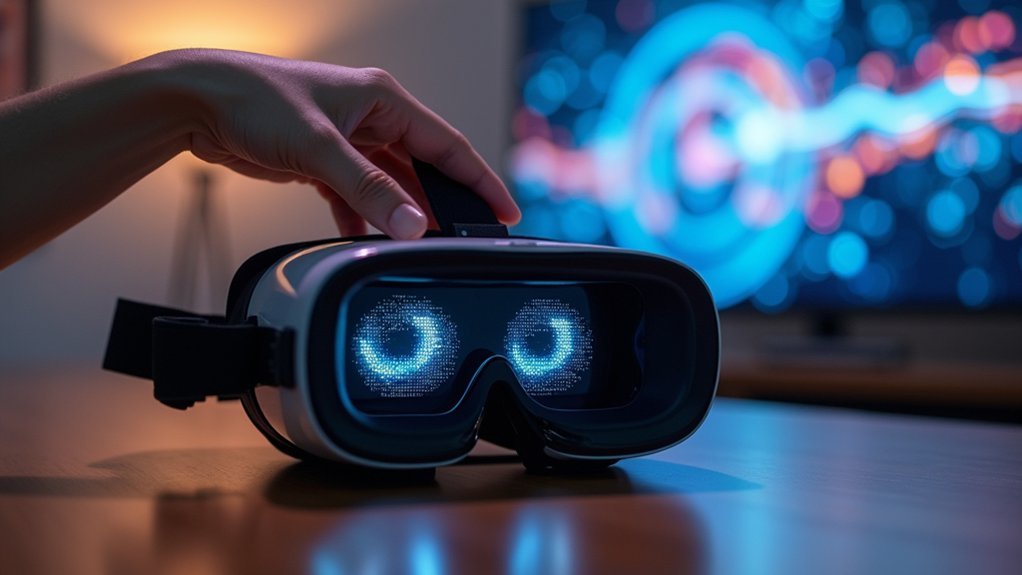Eye tracking calibration is essential because your headset can’t accurately determine where you’re looking without mapping your unique eye geometry. The system needs to compensate for the natural offset between your pupil center and fovea, plus account for individual variations like angle kappa and fovea position. This 10-30 second process creates a personalized correction function that transforms raw eye data into precise gaze coordinates, dramatically improving accuracy and reducing visual fatigue. Understanding these technical details reveals optimization strategies.
Understanding the Science Behind Eye Tracking Accuracy
When you look at an object, your eye’s fovea—the tiny region responsible for sharp vision—doesn’t align directly with your pupil’s center, creating an inherent challenge for eye tracking technology. This misalignment can cause significant errors in determining your Point-of-Regard without proper correction.
Your headset’s eye tracking accuracy depends heavily on the calibration process, which compensates for this natural offset. Geometric setup errors and computational model inaccuracies introduce systematic bias that skews visual behavior measurements.
Calibration errors create systematic bias that distorts measurements, making precise setup essential for accurate eye tracking data collection.
During extended sessions, you’ll need drift correction as your posture shifts and the device moves slightly.
Understanding these scientific principles explains why calibration isn’t optional—it’s fundamental to obtaining reliable data about where you’re actually looking versus where the system thinks you’re looking.
How Calibration Compensates for Individual Eye Variations
Since your eyes are as unique as your fingerprints, calibration must account for the distinctive anatomical features that affect how your headset interprets your gaze.
Eye tracking calibration addresses individual eye variations that can throw off gaze accuracy by several degrees. Your unique eye geometry, including fovea position relative to your pupil and your specific angle kappa, creates systematic tracking errors without proper calibration.
The calibration procedure typically uses 5 to 9 screen points to map your distinctive eye characteristics. This process accounts for your pupil diameter, iris size, and refractive errors like astigmatism that influence tracking performance.
The Technical Process of Mapping Gaze Points to Screen Coordinates
When you’re calibrating eye tracking in headsets, the system first captures raw data from your eye movements as you look at specific calibration targets on the screen.
It then applies coordinate transformation algorithms that convert these raw measurements into precise screen coordinates using mathematical models.
Finally, the system derives a correction function that accounts for your unique eye characteristics, creating an accurate mapping between where you’re actually looking and the corresponding digital coordinates.
Raw Data Acquisition
Although eye tracking technology has advanced considerably, the fundamental process of raw data acquisition remains a critical foundation that determines the accuracy of your entire gaze tracking experience.
During this phase, you’ll sequentially focus on designated calibration points displayed on your headset’s screen. The system captures your gaze information at each point, creating accurate mappings between your actual eye positions and the corresponding screen coordinates.
You’ll typically encounter 5 to 9 predefined points during this process. The system records these points of regard (PoR) and compares them against the displayed targets.
This eye tracking data accounts for individual differences like your unique foveal positioning and compensates for optical axis variations. The resulting correction function transforms raw measurements into precise gaze point coordinates, enabling reliable analysis of user interactions and visual behaviors.
Coordinate Transformation Algorithms
Once your eye tracker collects raw gaze data, sophisticated coordinate transformation algorithms take over to convert these measurements into precise screen coordinates. These algorithms correct for optical axis variations, angle kappa, and systematic biases that affect gaze accuracy. Your calibration data creates a correction function that adjusts the computed Point-of-Regard based on observed discrepancies.
| Algorithm Component | Function | Impact |
|---|---|---|
| Optical Correction | Adjusts for eye anatomy | Higher precision |
| Bias Compensation | Removes systematic errors | Improved accuracy |
| Multi-point Mapping | Creates reliable model | Better coverage |
| Dynamic Adjustment | Handles posture changes | Sustained performance |
| Real-time Processing | Instant coordinate updates | Smooth interaction |
Advanced systems incorporate real-time adjustments for posture changes and environmental factors, ensuring your eye movement translates into accurate on-screen interactions throughout extended use.
Correction Function Derivation
After transforming coordinates through the initial algorithms, your eye tracking system begins the critical process of deriving a personalized correction function that maps your gaze points to precise screen coordinates.
You’ll look at 5 to 9 calibration points displayed sequentially on your screen while the system records differences between your computed Point-of-Regard (PoR) and actual target locations. This data stream feeds into mathematical analysis that identifies systematic bias and misalignment patterns unique to your eyes and headset positioning.
The resulting correction function compensates for these discrepancies, transforming raw eye tracking technology measurements into accurate screen coordinates. This personalized calibration guarantees ideal gaze accuracy for seamless interaction within applications requiring precise eye-controlled navigation and selection.
Impact of Proper Calibration on User Experience and Comfort
When you properly calibrate eye tracking in your headset, you’ll immediately notice how it transforms your entire visual experience by ensuring your gaze point aligns accurately with the system’s detection capabilities.
This calibration process, taking just 10 to 30 seconds, dramatically improves your user experience by compensating for anatomical variations between your fovea and pupil. You’ll achieve superior gaze accuracy that eliminates the discomfort and disorientation caused by inadequate calibration.
With precise calibration using 5 to 9 calibration points, you’ll minimize visual fatigue during extended sessions. Your headset’s applications will respond correctly to your eye movements, creating a seamless immersive experience.
This accuracy proves especially important in virtual reality environments where precise eye tracking determines interaction quality and overall satisfaction.
Optimizing Calibration Procedures for Different User Types
Achieving ideal calibration accuracy requires tailored approaches that account for each user’s specific characteristics and experience level.
When working with inexperienced users, you’ll want to provide clear instructions that emphasize focusing directly on calibration points rather than guessing their locations. This simple guidance greatly improves gaze data quality.
Clear instructions to focus directly on calibration points, rather than guessing locations, significantly improves gaze tracking accuracy for inexperienced users.
For diverse user populations, consider increasing calibration points from five to nine, which considerably enhances accuracy across different visual characteristics.
You should also monitor users wearing glasses or those with astigmatism more closely, adjusting calibration as needed to accommodate their individual differences.
Additionally, match your calibration background color to stimulus brightness to minimize pupil center shifts.
Remember that maintaining comfortable posture throughout the process prevents misalignment issues that compromise tracking precision.
Managing Calibration Data Security and Multiple User Profiles
Since eye tracking calibration involves biometric data, you’ll need robust security measures that protect user privacy while enabling seamless multi-user functionality. Devices like HoloLens 2 store calibration data locally, ensuring your eye movements remain secure and account-agnostic. This approach prevents unauthorized access while maintaining ideal tracking performance.
| Feature | Capability | Benefit |
|---|---|---|
| Profile Storage | Up to 50 profiles | Multiple users without interference |
| Data Location | Local device storage | Enhanced user privacy |
| Account Linking | None required | No historical tracking |
You can manage profiles through device settings, easily deleting or overwriting existing calibration data as needed. New users receive calibration prompts upon first use, ensuring immediate enhancement. This system balances data security with practical multi-user access, protecting your biometric information while maintaining device functionality across different users.
Addressing Common Calibration Challenges and Solutions
While secure profile management forms the foundation of effective eye tracking systems, calibration accuracy depends heavily on how well you handle the technical and environmental challenges that can disrupt the process.
You’ll encounter several common issues that affect eye gaze precision. Environmental factors like background color and your posture create significant accuracy variations, so maintain consistent conditions throughout sessions.
Environmental factors like background color and posture create significant accuracy variations, so maintain consistent conditions throughout calibration sessions.
When instructing participants, emphasize looking directly at calibration points rather than guessing locations—inexperienced users often struggle with maintaining proper focus during the process.
You won’t need frequent recalibration unless major environmental changes occur, but implementing drift correction becomes essential for long-duration experiments to preserve measurement reliability and prevent systematic bias accumulation.
Frequently Asked Questions
What Is Calibration in Eye Tracking?
Calibration computes your eye’s systematic and biometric characteristics to accurately determine where you’re looking. You’ll look at specific screen points so the system can create a correction function that adjusts your point-of-regard.
Why Is My Eye Not Tracking Correctly?
Your eye isn’t tracking correctly because you haven’t calibrated properly, environmental conditions changed, you’re wearing glasses, or drift occurred during extended use requiring recalibration.
What Does Calibrate the Eyes Mean?
Calibrating your eyes means adjusting the eye tracking system to match your unique anatomy. You’ll look at specific points on screen so the headset learns where you’re actually gazing for accurate tracking.
Why Is Eye Tracking Important?
Eye tracking’s important because it lets you control virtual environments naturally with your gaze, personalizes content based on where you’re looking, and dramatically improves graphics performance through foveated rendering.
In Summary
You’ll find that proper eye tracking calibration isn’t just a technical formality—it’s essential for accuracy and comfort. When you take time to calibrate correctly, you’re ensuring the system understands your unique eye characteristics and delivers precise gaze tracking. Don’t skip this step, as poor calibration leads to frustrating experiences and inaccurate data. Remember, you’re investing a few minutes upfront for markedly better performance throughout your entire session.





Leave a Reply